At a price that many deem to be the entry into a bike worthy of off-road abuse, the Marlin 7 sits in a highly competitive market segment. Where the now more expensive X-Caliber once held this price point for Trek, it’s the Marlin that steps up to the plate.
With large 29er wheels, big-brand components and proven handling, we were eager to see how the 2017 Marlin 7 behaved when taken to the mountain. Taking this bike onto our regular trails proved that it should be on your short-list for a starter mountain bike under AU$1,000. Read on to find out why.
- Who’s it for: Those looking to get started in mountain biking or for leisurely rides on varied surfaces
- What we like: Proven handling, solid feel on trail, reliable components
- What we don’t: High weight (not an issue specific to this bike, it’s characteristic of 29ers at this price), twisting grips
Trek is no stranger to the 29er-wheeled mountain bike, with its now-discontinued Gary Fisher brand effectively creating the 29er market as early as 2001. Eventually these bikes morphed into the Trek’s we see today, but not before the Gary Fisher brand had arguably perfected the geometry of the big wheel frames, well before many other top brands had looked beyond the tried-and-true 26in wheels.
The Marlin frame
Made of Trek’s self-branded ‘Alpha Silver’ aluminium, the Marlin offers a relatively basic, yet perfectly solid frame as the bike’s foundation. The frame features are kept simple with only subtle shaping to the tubes to give them additional strength, simple pannier and fender mounts and a classy coat of paint (three colours to choose from).
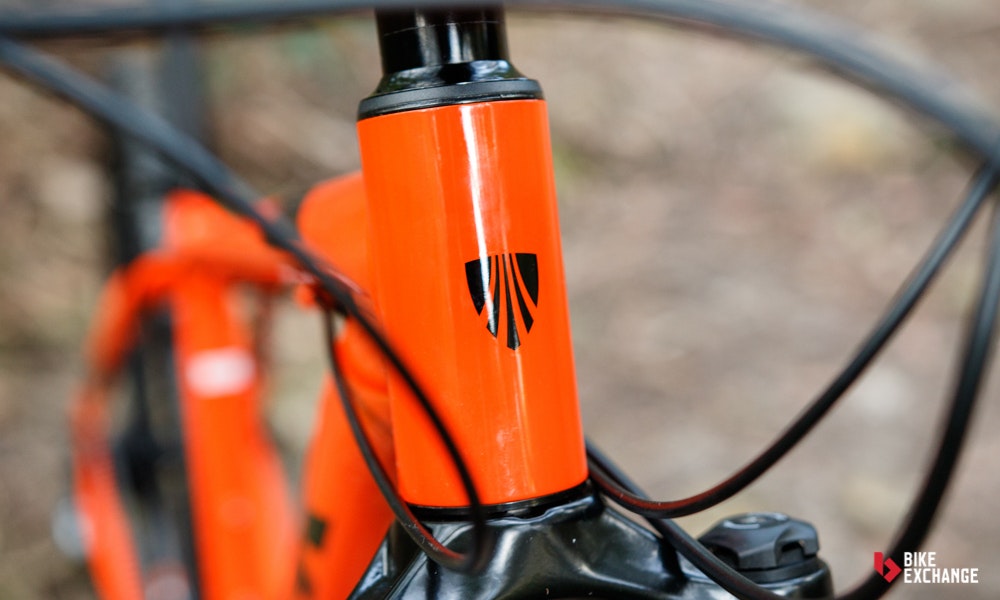
Being simple in features doesn’t mean this frame is lacking in quality though. All the welds are consistent, the alignment is spot on and the oversized shapes provide for plenty of stiffness and strength.
Looking to the X-Caliber in the pricepoint above and a change in frame makes up most of the price difference. Here, the X-Caliber’s frame features ‘Alpha Gold’ aluminium which is then butted and manipulated to create a frame that offers a lower weight and a smoother ride without sacrificing on strength.
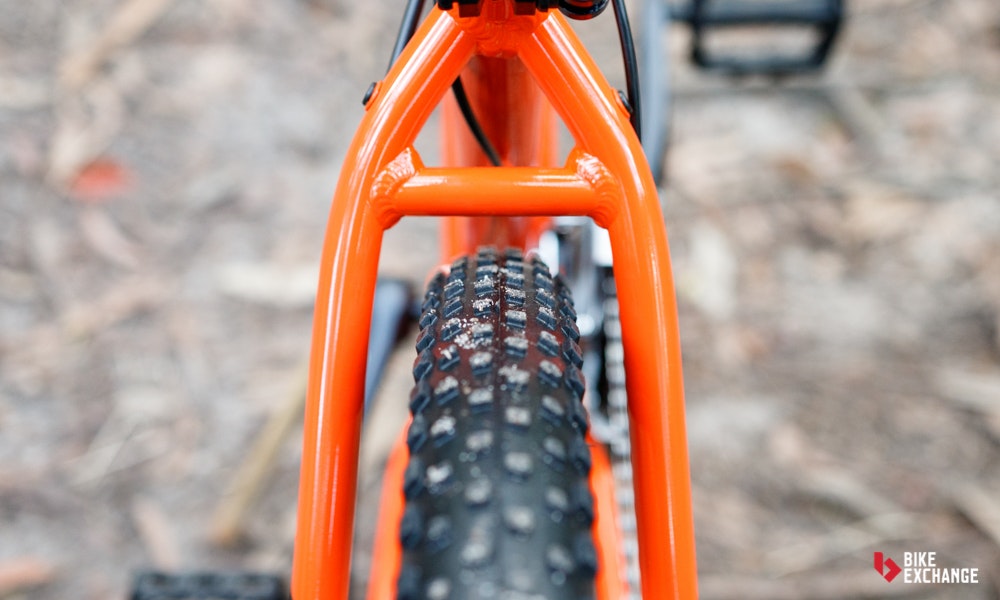
Plenty of tyre clearance exists out back for wider rubber
Geometry is key
Frame construction and materials aside, it’s the angles and dimensions that have the biggest affect on the trail. As mentioned previously, Trek has had longer than just about any other brand to dial in its geometry for use with 29er wheels, and the Marlin offers geometry quite near to its more expensive siblings.
Known as ‘G2’ geometry, Trek claim that its 29er-specific designs create a more natural and reactive handling characteristic. A large part of this starts at the fork offset, where the wheel sits some 5mm further in front compared to many other 29er-equipped mountain bikes. First found on the Gary Fisher bikes, this longer offset fork was once specific to Trek, but is now widely adopted by others.
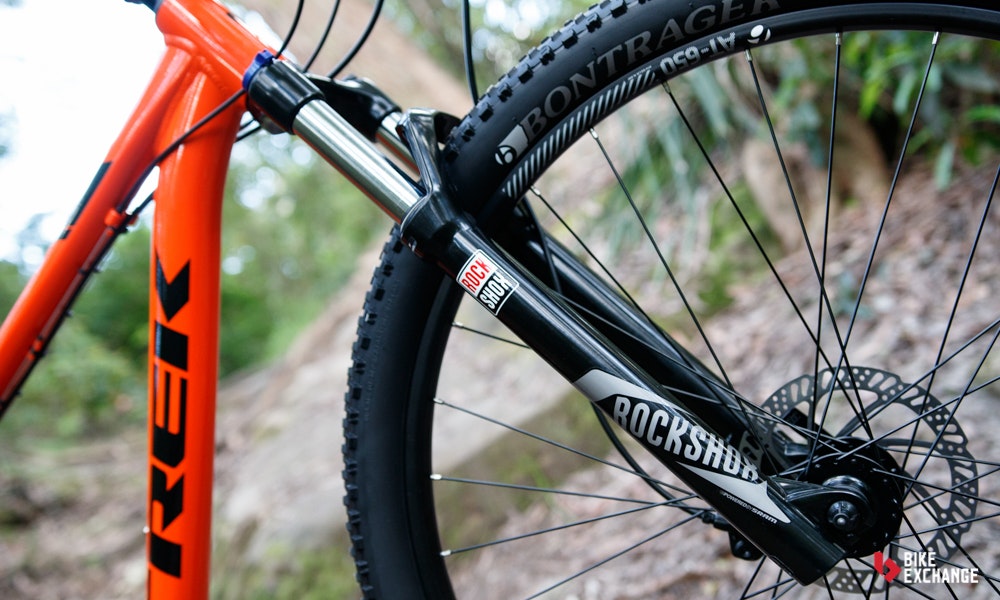
By offsetting the wheel forward, the handling becomes more reactive. Other brands achieve this quicker handling by steepening the steering angle (head tube angle), but this often creates a nervous and ‘twitchy’ ride characteristic. By contrast, the Trek uses a slacker head angle for descending stability, while handling is kept responsive. This special offset fork remains a rarity on bikes of the Marlin’s price and makes a true difference to how the bike behaves off-road.
Further to this, the Marlin offers a modern longer length across its top tube. This is combined with a shorter stem to provide roomy reach to the handlebar, while helping to keep your weight well centred between the wheels.
Trek offer one of the most generous size ranges, especially given the 18.5in frame (as tested) effectively sits between many other brands popular medium and large sizes. This means you’re more likely to find a precise fit with a Marlin than many other choices.
One aspect of Trek’s bike sizing to be aware of is that the smallest frame size replaces the big 29er wheels with smaller 27.5in hoops. This is dubbed ‘Smart Wheel Size’ and helps to ensure that the smallest frame size, and its ride, isn’t compromised just to fit the big wheels.
Big brand components
A quick glance of the specification list and reality of this pricepoint sets in. The Marlin 7 features a mix of big-brand components, but many of which are fairly basic.
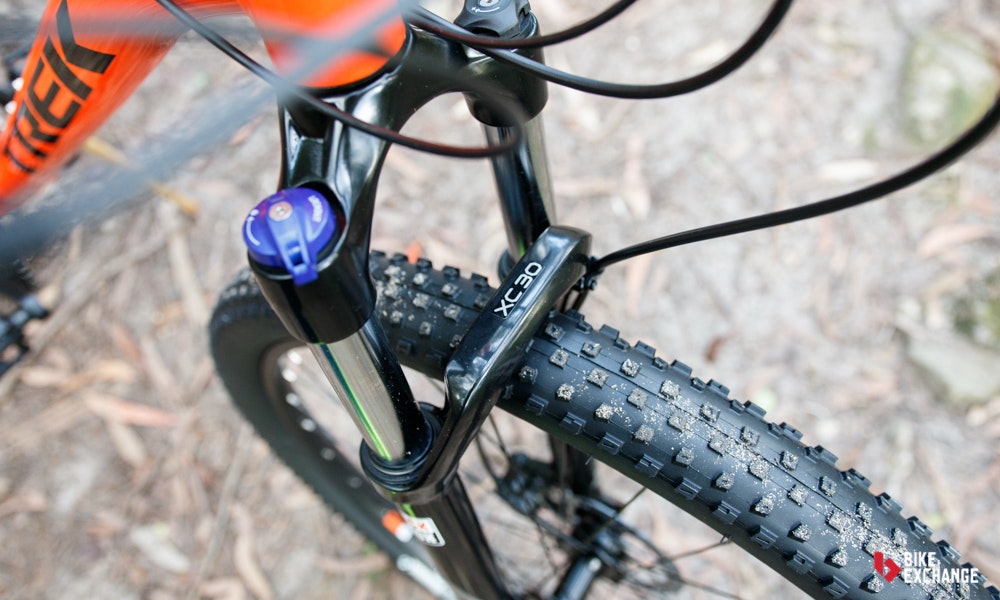
After the frame, the front suspension is the most important component. The RockShox suspension fork up front is a key feature to this bike, with the sticker alone adding some prestige. Regardless of the label, this is still a basic fork with a simple lockout on one side and control of the preload on the fork’s spring at the other side. While it is hydraulic damped, it doesn’t offer the external rebound control that some bikes of this price are starting to offer – a function that controls how fast the fork returns to its full height once compressed. It’s a feature found on the X-Caliber model above.
Another aspect to consider with suspension forks is the stanchion tube diameter. Simply put, the larger tube diameter will typically result in a stiffer fork that lets the front wheel go where the handlebars point. 32 or 34mm forks dominate the premium hardtail and dual suspension mountain bike market these days. The Marlin’s ’XC30’ gets its name from the 30mm stanchions, a skinny size that is near standard on bikes of this price.
Next inline of importance are the wheels, with Trek’s own component brand ‘Bontrager’ featuring at the double-walled rims. While they’re built tough for abuse, these fairly no-frills wheels hold plenty of weight within them. It wouldn’t be a review if we didn’t nitpick, and with that, the Formula rear hub on our sample was a little noisy straight out of the box. The noise didn’t affect its function, but we decided to open it up and silence it (it helped a bit) with fresh grease anyway – a procedure best left to your shop as it requires a handful of bike-specific tools and a little knowledge.
Wrapping the wheels are a pair of Bontrager XR2 wire bead tyres. What’s interesting is that Trek have equipped a wider 2.2in model to the front wheel, with a narrower 2.0in version out back. This is a popular practice on mountain bikes, where the lead front tyre offers greater control and grip, with the following back tyre saving weight.
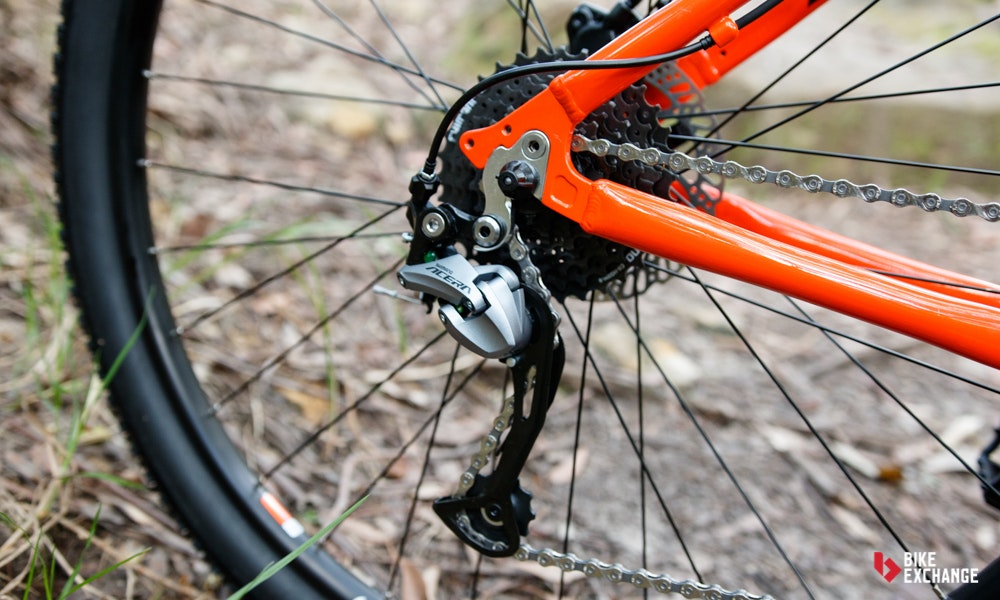
It’s the gears of the bike that most will compare models with. In reality, the functional difference between Shimano Altus and Acera is marginal and so the model of derailleur or shifter shouldn’t be a deciding factor for your new bike. In the Marlin’s case, the gears equipped work exactly as required and it’s nice to see all but the chain being from Shimano’s catalogue. Here, three cogs at the front match with nine at back to make a 27-speed drivetrain with huge range.
Last point of note is the disc brakes, with Tektro providing a entry-level hydraulic model. These offer lever reach adjustment to dial in how far the brake lever sits from the bar, while the hydraulic nature offers smooth brake control and low maintenance.
All told, our test sample weighs in at 14.2kg without the included plastic pedals. It’s a high weight, but a fairly common number for 29er mountain bikes of this price.
Ride impressions
Component lists aside, what matters most is how it feels on the trail, and the Marlin steers with similar poise to its more expensive X-Caliber, Superfly and even Pro-Caliber siblings. It’s off-road that the subtle differences in Trek’s geometry really shine and almost immediately we felt confident bombing down descents on this entry-level ride.
The ride on rough surfaces is well controlled and the big-bag 29er tyres do well to soak up the chatter. The Marlin’s frame is a stiff one though, and so there’s no respite from the bumps that make it past the compression of the rear tyre.
Up front, the RockShox fork feels well controlled and does a decent job absorbing bigger hits, while keeping front wheel traction. Fast, repetitive trail bumps can quickly overwhelm the fork, but it’s well mannered in most conditions. To our surprise, we didn’t miss the lack of rebound adjustment as much as first thought, mostly due to the stock setting offering decent control and preventing this fork from springing back with aggression.
Handling is inline with what we’ve come to expect of a modern 29er, where even the tightest of singletrack corners are no struggle to get through. Ride the Marlin hard enough and you’ll feel the flexible fork complain, with the bike understeering to the demand given. Though its hardly something to worry about, as just about all bikes of the price will suffer such a fate.
To get the most out of this bike off-road you’ll likely want to lower the handlebar height from its highest point. This adjustment is easily done and will allow your body weight to help that front wheel bite into the dirt and better balance the handling.
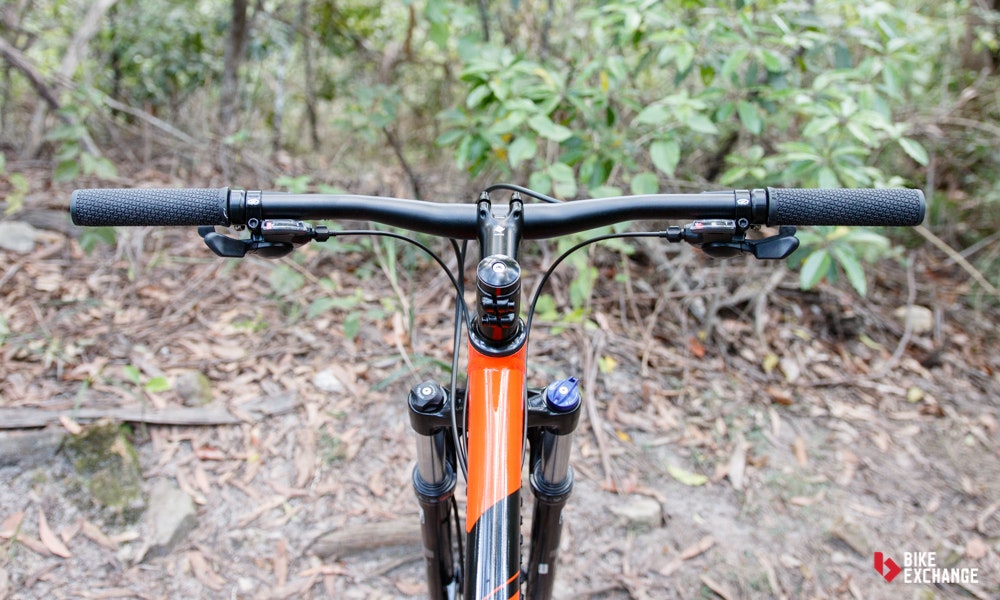
The bike’s geometry and fork shouldn’t earn all the praise, as it’s the little components that help too. The handlebars and mid-length stem offer a comfortable hand position and offer reasonable leverage over the big wheels. The brakes lack the feedback of more expensive options, but they’ll reliably haul you to a stop whenever needed.
The Bontrager tyres offer decent traction in a variety of conditions and the larger volume at the front is a nice touch, but if you were looking to drop this bike’s weight below 14kgs, new rubber should be your first point of action.
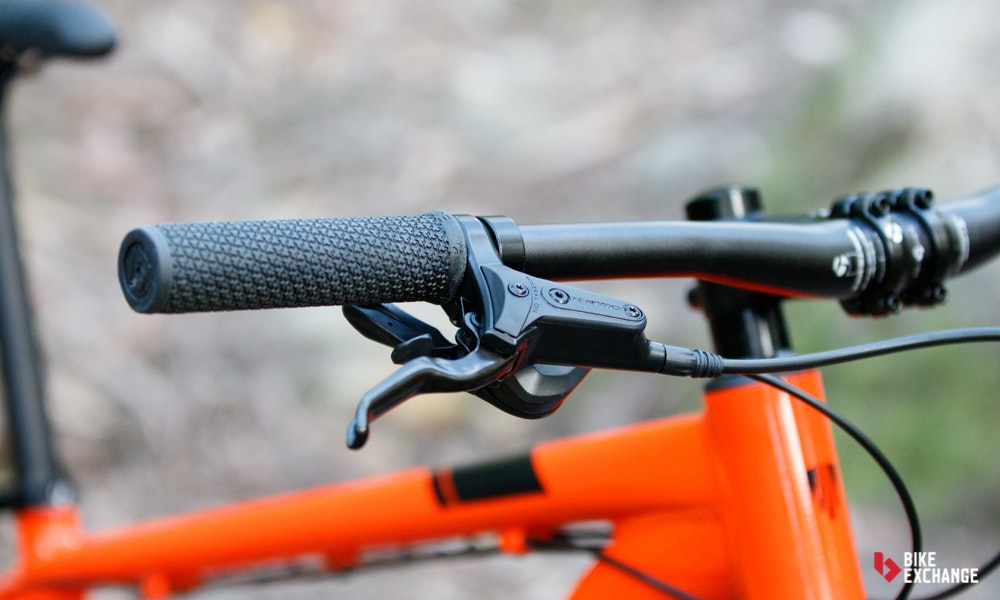
However, it’s not all perfect. The rubber grips slowly turn on the bars and so would be the first part we’d suggest changing for the keen mountain bikers. Likewise for the included plastic pedals which lack grip when wet, either changing to a metal version or a clipless pedal would be a great upgrade.
Heading back up the hill and the Marlin goes where it is pointed, but the sheer weight of the bike means the ascent can be a crawl. Thankfully the 27-speed drivetrain offers incredibly low gearing to spin your way back to the top, but just don’t expect to beat the experienced whippets there.
On that point, it’s commonly said that 29er mountain bikes make for great all-round bikes and commuters as the rim size is equal to what 700c road bikes use. However, our opinion is that if you’re looking for a bike to solely use for commuting, without any ambition to ever go off-road, then there are better, more focused bikes to choose. Sure, the Marlin’s front fork lockout helps it on the road, but the overall weight and position is optimised for tackling off-road terrain, and it’s fairly slow and hard going when on the tarmac.
Conclusion
While we’ve drawn plenty of similarities of the Marlin and Trek’s more expensive models, it’s important to be clear that you do get what you pay for. Yes, the Marlin offers proven geometry that serves as a strong foundation into mountain biking, but its high weight is the true limitation of the price point. If you can stretch to the X-Caliber, then the more refined frame is money well spent.
However, if your budget sits at a firm AU$1,000 and the trails are calling, then the Marlin 7 should certainly be on your short-list. With handling characteristics that are widely imitated but rarely matched, you’ll certainly have fun on this ride.
The Trek Marlin 7 is available in sizes 15.5 (27.5in wheels), 17.5, 18.5 (tested), 19.5 and 21.5in. Our sample sits on the scales at 14.2kg (without pedals and bottle cages). The RRP is AUD$949. Sharing the same frame, there's also the Marlin 6 and Marlin 5, which retail for AU$799 and AU$649 respectively.
For in-depth help of where to start in your mountain bike research, read our complete guide to buying a mountain bike.
Follow BikeExchange: Email | Facebook | Twitter | Instagram | YouTube | STRAVA





